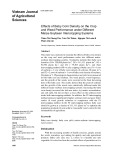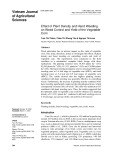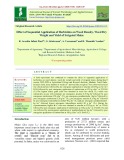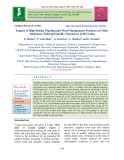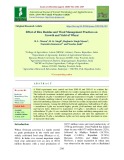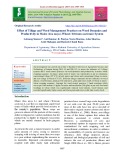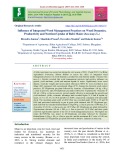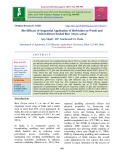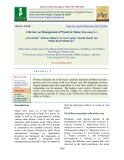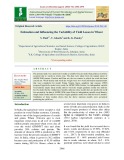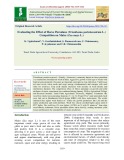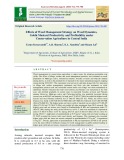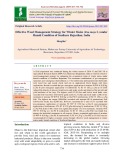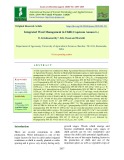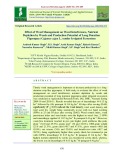
Weed density and yield
-
This study was conducted to examine the effects of baby corn density on the crop and weed performance under two different maizesoybean intercropping systems. The results showed that the yield of soybean and the growth of the weeds were statistically different under the different maize-soybean intercropping systems.
 14p
14p  viengels
viengels
 25-08-2023
25-08-2023
 5
5
 2
2
 Download
Download
-
This study, therefore, aimed to investigate the effects of plant density and hand weeding on controlling weeds and yield of vegetable corn. The experiments were conducted in the field condition in a randomized complete block design with three replications.
 14p
14p  chauchaungayxua12
chauchaungayxua12
 09-07-2021
09-07-2021
 17
17
 1
1
 Download
Download
-
To overcome this problem, use of herbicides has become an alternative method. Herbicide application is easier and economical to farmers compared to other weed management practices. Hence the present study deals with the effect of different weed management practices on weed density, weed dry weight and seed cotton yield.
 6p
6p  chauchaungayxua10
chauchaungayxua10
 19-03-2021
19-03-2021
 12
12
 1
1
 Download
Download
-
A field experiment was conducted to evaluate the effect of sequential application of herbicides on weed density, weed dry weight and yield of irrigated maize during kharif season, 2019-2020 at Agricultural College and Research Institute, Madurai, Tamil Nadu
 8p
8p  chauchaungayxua10
chauchaungayxua10
 19-03-2021
19-03-2021
 15
15
 1
1
 Download
Download
-
Jute cultivation is a labour-intensive activity. Small and marginal farmers extensively practice high density sowing (HDS) by broadcasting jute seed. High plant stand due to HDS at emergence increases major operational expenses of weeding and thinning, sorting and fibre extraction. To investigate effects of low density sowing (LDS)on production potential of fibre and green biomass and possible reduction in man-days and cost of cultivation, field experiment was conducted at ICAR-CRIJAF farm and it was also repeated through farmers’ field trials in four different locations
 9p
9p  trinhthamhodang1216
trinhthamhodang1216
 19-11-2020
19-11-2020
 15
15
 2
2
 Download
Download
-
In view of the above, present research work carried out with the objective to find out the effect of High Density Planting System (HDPS) and weed management practices on on yield and quality of Bt cotton.
 9p
9p  nguathienthan8
nguathienthan8
 20-10-2020
20-10-2020
 13
13
 1
1
 Download
Download
-
A Field experiments were carried out from 2009-10 and 2010-11 to evaluate the efficiency of herbicides under different rice residue management practices in wheat. The herbicide treatments included application of sulfosulfuron alone and tank mix Sulfosulfuron 25 g/ha + metsulfuron 4 g/ha and isoproturon 1.0 kg/ha + metsulfuron 4 g/ha. Residue mulching reduced weed density, resulting in improvement of growth and yield attributing characters of wheat followed by residue incorporated and residue retained treatments.
 7p
7p  nguaconbaynhay7
nguaconbaynhay7
 15-08-2020
15-08-2020
 13
13
 1
1
 Download
Download
-
An investigation was carried out at Sher-e-Kashmir University of Agriculture Science and Technology of Jammu during 2013-14 and 2014-15, to assess the influence of 4 tillage systems and 3 weed-control practices on weed dynamics and productivity in maize-wheat cropping sequence. In maize, grain yield of maize was statistically at par in continuous conventional tillage (CT-CT) in both maize and wheat and conventional tillage in maize and zero tillage in wheat (CT-ZT).
 7p
7p  angicungduoc6
angicungduoc6
 20-07-2020
20-07-2020
 18
18
 1
1
 Download
Download
-
A field experiment was carried out during the rabi season of 2011-12 and 2012-13 at Bihar Agricultural University, Sabour (Bihar) to assess the effect of integrated weed management practices on weed dynamics, productivity and nutrient uptake of maize (Zea mays L.). Results revealed that weed management practices had positive influence on growth, yield attributes, yields and nutrient uptake of maize. Significantly lower weed density, weed dry weight and weed control efficiency (WCE %) were recorded in zero tillage (ZT) compared with conventional tillage (CT).
 10p
10p  angicungduoc6
angicungduoc6
 20-07-2020
20-07-2020
 22
22
 2
2
 Download
Download
-
A field experiment was conducted during kharif 2012 to evaluate the efficacy of different pre and post emergence herbicides in direct seeded rice. The chemical treatments included two pre-emergence herbicides namely pendimethalin 1000 g/ha and oxadiargyl 100 g/ha and four post-emergence herbicides viz. bispyribac-sodium 25 g/ha, fenoxaprop 67 g/ha, ethoxysulfuron 18.75 g/ha and chlorimuron-ethyl +metsulfuron-methyl RM 4 g/ha at 25 DAS. Weed free and weedy check were also included.
 6p
6p  trinhthamhodang6
trinhthamhodang6
 09-07-2020
09-07-2020
 10
10
 2
2
 Download
Download
-
The use of organic and inorganic mulch as a soil cover is effective in improving growth and yield of chilli (Capsicum annuum L.). A field experiment was carried out at College Orchard, Department of Vegetable Crops, Horticultural College and Research Institute, Tamil Nadu Agricultural University, Coimbatore during 2013 to 2016 to study the effect of different types of mulches viz., organic mulch @ 6.0 t/ha, organic mulch @ 9.0 t/ha, organic mulch @ 12.
 9p
9p  chauchaungayxua6
chauchaungayxua6
 26-06-2020
26-06-2020
 8
8
 1
1
 Download
Download
-
Weeds constituent one of the major economic important problem for maize growers and it can reduce yield up to 86 per cent. The magnitude of losses largely depends upon the composition of weed flora, period of crop-weed competition and its intensity. The highest weed control efficiency with lowest weed density and weed dry weight was noted in pre-emergence application of atrazine @ 1.0 kg a.i. ha-1 followed by (fb) one hand weeding (HW) at 30 DAS.
 17p
17p  caygaocaolon5
caygaocaolon5
 27-05-2020
27-05-2020
 11
11
 2
2
 Download
Download
-
A field experiment entitled “Efficacy of pre and post-emergence herbicides on growth and yield of chickpea (Cicer arietinum L.)” was conducted at Agricultural Research Station, Mandor, Jodhpur during rabi season of 2016-17. Field experiment was laid out in randomized block design (RBD) with sixteen treatments and replicated thrice. Sixteen treatments were tested among that two doses of each herbicides i.e. pendimethalin (0.40 and 0.60 kg a.i./ha), oxyfluorfen (100 and 200 g a.i./ha), imazethapyr (40 and 60 g a.i.
 10p
10p  trinhthamhodang5
trinhthamhodang5
 16-05-2020
16-05-2020
 13
13
 0
0
 Download
Download
-
The present study was carried out to make a suitable forecast model that predicts yield loss occurred due to weeds in wheat crop. The data were taken from the annual report of AICRP-WM centres. Gwalior and Pusa are the two centres in which the work has been carried out. Weed density and weed dry weight were two weed infestation measurements that were considered for model fitting.
 5p
5p  chauchaungayxua5
chauchaungayxua5
 08-05-2020
08-05-2020
 11
11
 1
1
 Download
Download
-
Trianthema portulacastrum L. (Family: Aizoaceae), commonly known as horse pursulane is a troublesome broadleaved weed in India. Aggressive growth of this type of weeds with high invasion potential it becomes an important constraint in crop cultivation. Yield losses are most severe when weeds and crops emerge simultaneously and compete with each other for resources. Crop yield usually decreases with increase in weed density and interference duration.
 5p
5p  chauchaungayxua5
chauchaungayxua5
 05-05-2020
05-05-2020
 11
11
 2
2
 Download
Download
-
Weed management in conservation agriculture is major issues for attaining sustainable crop yields. The effect of tillage, residue and weed management practices was evaluated on weed population of Medicago sativa, Chichorium intybus, Sonchus arvensis and Physalis minima among dicots, as well as the productivity of mustard in the maize-mustard-greengram cropping system during 2015-2017.
 13p
13p  nguathienthan4
nguathienthan4
 18-04-2020
18-04-2020
 18
18
 1
1
 Download
Download
-
Potato is one of the most important commercial vegetable crops in India and on an average this crop is affected by weeds damage which should be prevented by various control methods. Cultural operations and mulches are non-chemical methods of weed control in sustainable agricultural systems. The aim of present study was to investigate the effect of chemical and non-chemical control methods on weeds and yield of potato crop.
 11p
11p  cothumenhmong3
cothumenhmong3
 22-02-2020
22-02-2020
 20
20
 1
1
 Download
Download
-
A field experiment was conducted during the winter season of 2016-17 and 2017-18 at Agricultural Research Station (MPUAT), Banswara (Rajasthan), India to find out effective weed management strategy for enhancing the economical return of winter maize under humid condition of Southern Rajasthan. Ten treatment combinations of pre-emergence (atrazine), post-emergence (halosulfuron, 2, 4-D, tembotrione and topramezone) herbicides with weed free and weedy check laid out in randomized block design with three replications. Results revealed that pre-emergence application of atrazine 50 WP @ 0.
 13p
13p  trinhthamhodang3
trinhthamhodang3
 12-02-2020
12-02-2020
 12
12
 0
0
 Download
Download
-
A field experiment was conducted at Main Agricultural Research Station Farm, University of Agricultural Sciences, Raichur in Hyderabad Karnataka region, to study integrated weed management in chilli (Capsicum annum L.). An experiment comprising ten treatments viz. Propaquizafop 10% EC PoE (postemergence) @ 500 ml ha-1 (50 g a.i.), Propaquizafop 10% EC PoE @ 625 ml ha-1 (62.5 g a.i.), Propaquizafop 10% EC PoE @ 750 ml ha-1 (75 g a.i.), Propaquizafop 10% EC PoE @ 1250 ml ha-1 (125 g a.i.), Pendimethalin 30% EC PRE (preemergence) @ 4160 ml ha-1 (1250 g a.i.
 9p
9p  nguaconbaynhay3
nguaconbaynhay3
 07-02-2020
07-02-2020
 17
17
 1
1
 Download
Download
-
Timely weed management is important to increase productivity in s longduration crop like pigeonpea. A field study to evaluate the effect of weed management on weed interference, nutrient depletion by weeds and production potential of long duration pigeonpea under irrigated ecosystem was conducted at Agricultural Research Farm, IAS, BHU, Varanasi during 2009-10 and 2010-11. Results revealed that use of imazethapyr @ 0.15 kg ha-1 followed by (fb) paraquat @ 0.4 kg ha-1 40 days after sowing (DAS) significantly (P ≤ 0.
 14p
14p  nguaconbaynhay3
nguaconbaynhay3
 07-02-2020
07-02-2020
 30
30
 1
1
 Download
Download
CHỦ ĐỀ BẠN MUỐN TÌM









